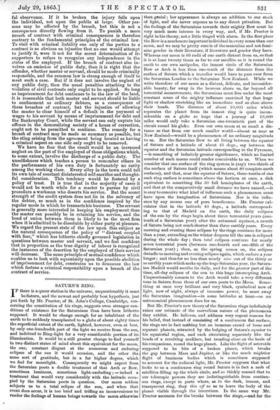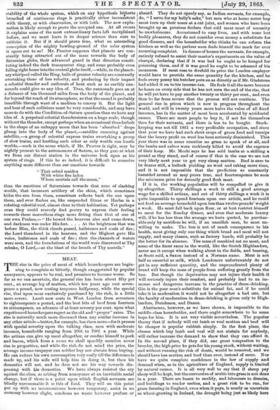SATURN'S RING.
IF there is a queer station in the universe, unquestionably it must be Saturn, and the newest and probably best hypothesis, just put forth by Mr. Proctor, of St. John's College, Cambridge, con- cerning the constitution of his rings, suggests even stranger con- ditions of existence for the Saturnians than have been hitherto supposed. It would be change enough for an inhabitant of the earth to be suddenly transplanted to a globe of about eighty times the superficial extent of the earth, lighted, however, even at best, by only one-hundredth part of the light we receive from the sun, and indebted to Ring-light for a very considerable portion of its illumination. It would be a still greater change to find yourself in two distinct states of mind about this equivalent for the moon, the one, constant disgust at the numerous and enduring eclipses of the sun it would occasion, and the other the same sort of gratitude, but in a far higher degree, which we feel for moonlight. Consequently we might expect from the Saturnian poets a doable treatment of that Arch or Bow, sometimes luminous, sometimes light-excluding ; — indeed a treatment that would vary considerably with the latitude occu- pied by the Saturnian poets in question. Our moon seldom subjects us to a total eclipse of the sun, and when that event does occur, it is too brief and trifling an inconvenience to render the feelings of human beings towards the moon otherwise than genial ; her appearance is always an addition to our stock of light, and she never exposes us to any direct privation. But the feelings of the Saturnians towards their mighty Bow must be very much more intense in every way, and, if Mr. Proctor is right in his theory, not a little tinged with alarm. In the first place the Bow is a muchmore importantindividual in every sense than our moon, and we may be pretty sure is of the masculine and not femi- nine gender in their literature, if literature and gender they have. Whereas our moon is 60 radii of our earth distant from us, so that it is at least twenty times as far to our satellite as it is round the earth to our own antipodes, the inmost circle of the Saturnian Bow or Arch is less than one-tenth of the distance from the surface of Saturn which a traveller would have to pass over from the Saturnian London to the Saturnian New Zealand. While we write therefore of our moon as a distant, delicate, and inconsider- able beauty, far away in the heavens above us, far beyond all terrestrial measurements, the Saturnians must live under the most constant sense of the mighty influence exercised by that huge light or shadow stretching like an immediate roof so close above their heads. The distance of about 10,000 miles which separates the planet from its inmost ring is quite incon- siderable on a globe so huge that a journey of 10,000 miles would only take a Saturnian one-twentieth part of the circuit round his globs. Even our own moon at so small a dis- tance as that from our much smaller world—almost as near as New Zealand—would be a phenomenon of no ordinary magnitude to us. But the Saturnian Bow to all living between the equator' of Saturn and a latitude of about 45 degs., say between the equator and the Saturnian latitude corresponding to the Pyrenees, —is something of infinitely greater significance, which no limited number of such moons could render conceivable to us. When we consider that one surface of the ring system is (say) two-thirds of the surface of Saturn itself (which means about 80 complete earth surfaces), and that, near the equator of Saturn, three-tenths of one such ring surface is sometimes above the horizon at once, a disk equivalent to something like 30 full hemispheres of the earth, and that at the comparatively small distance we have named,—it is easy to conceive what kind of influence such a phenomenon must have upon the imagination of Saturnians. Nor is the influ- ence by any means one of pure beneficence. Mr. Proctor cal- culates that in the latitude 40 degs., a latitude correspond- ing to that of Madrid on the earth, the daily eclipses of the sun by the rings begin about three terrestrial years (one- tenth of a Saturnian year) after the autumnal equinox, a month of Saturn being not much shorter than three earthly years. Every morning and evening these eclipses by the rings continue for more than a year, extending as the winter deepens till the sun is eclipsed during the whole day ; then total eclipses continue for nearly seven terrestrial years (between one-fourth and one-fifth of the Saturnian year) ; then, as the spring comes on, the eclipses dwindle to morning and evening eclipses again, which endure a year longer; and thus for no less than nearly nine out of the thirty or so earthly years which make up the huge Saturnian year, the Saturn- ian Madrid would ascribe its daily, and for the greater part of the time, all-day eclipses of the sun to this huge intercepting Arch. Unquestionably sonnets to the Arch would take a very different tone in Saturn from those of our own poets to the Moon. Some- thing at once very brilliant and very black, symbolical now of light, now of night, always of immense power, he must sway the Saturnian imagination—in some latitudes at least—as no astronomical phenomenon does for us.
But Mr. Proctor's new theory of the Saturnian rings indefinitely raises our estimate of the marvellous nature of the phenomena
they exhibit. He believes, and adduces very cogent reasons for his belief, that instead of consisting of a continuous flat surface,
the rings are in fact nothing but an immense crowd of loose and separate planets, attracted by the bulging of Saturn's equator to his equatorial region, and each circulating separately like the beads of a revolving necklace, but treading close on the heels of his companions, round the huge planet. Like the flight of asteroids supposed to be bits of a broken planet, which breaks the gap between Mars and Jupiter, or like the much mightier flight of luminous bodies which is sometimes supposed to account for the zodiacal light, Mr. Proctor supposes that what looks to us a continuous ring round Saturn is in fact a mob of satellites filling up the whole circle, and so thickly massed that to our telescopic powers they are indistinguishable from continu-
ous rings, except in parts where, as in the dark, inmost, and transparent ring, they thin off so as to leave the body of the planet visible through the interstices. In the same way Mr. Proctor accounts for the breaks between the rings,—and for the
stability of the whole system, Which oil any hypothesis hitherto broached of continuous rings. is ptactiddly either inconsistent with theory, or with observation, or With both. The new expla- nation is likely enough to prove the aecepted one. At all events it explaiMi some of the most extraordinary facts left iinettillined before, and we must leave it to deeper' science than oats to criticize it. But if it should prove true, what an astounding conception of the mighty bowling-ground of the solar system it opens out to us! Mr. Proctor supposes that planets are con- stantly being attracted out of the mass towards the body of Saturnian globe, their advanced guard in that direction consti- tuting indeed the dark transparent ring, and some probably even falling right home intothe central globe itself,—while, in the planet- ariwliiilpool called the Ring, balls of greater velocity are constantly overtaking those of less velocity, and producing by their impact a celestial thunder and outbursts of heat such as no earthly can- nonade could give us any idea of. Trite, the cannonade goes on at a distance of ten thousand miles from the body of the planet, and far beyond the reach of its atmosphere, so that the sound is probably inaudible through want of a medium to convey it. But the light and heat of such collisions must be very considerable, and may have more to do with the Condition-of-Saturn question than we have any idea of. A perpetual celestial thunderstorm on a huge scale, though withoutthe thunder, except perhaps when an occasional thunderbolt in the shape of an unhappy moon that has been 'absorbed' drops plump into the body of the planet,—satellite canoning against satellite,—a group of celestial express trains overtaking a group of slow trains, and hustling each other as only worlds can hustle worlds,—such is the scene which, if Mr. Proctor is right, may be nightly present to the astronomers of Saturn, as they gaze at what we from our distant station in the universe look upon as his system of rings. If this be so indeed, it is difficult to conceive anything mote different than out emotions towards "That orbed maiden With white fire laden Whom mortals call the moon," than the emotions of Saturnians towards that zone of clashing worlds, that incessant artillery of the skies, which sometimes tides the sun from them, sometimes reflects back the sun upon them, and ever flashes on, like suspended Etnas or Heclas in a rotating celestial roof, almost close to their habitation. Yet perhaps even they could scarcely find poetry to express their feeling towards these marvellous rings more fitting than that of one of our own Psalms,—" He bowed the heavens also and came down, and dartness was under His feet. . . . At the brightness that was before Him, the thick clouds passed, hailstones and coals of fire ; the Lord thundered in the heavens, and the Highest gave His voice, hailstones and coals of fire ; then the channels of waters were seen, and the foundations of the world were discovered at Thy rebuke, 0 Lord,—at the blast of the breath of Thy nostrils."































 Previous page
Previous page